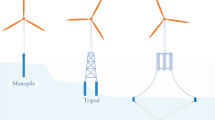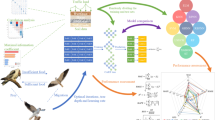Abstract
This paper presents new numerical evaluations of the vertical uplift resistance of rectangular anchors located in heterogeneous and anisotropic clays obeying the Anisotropic Undrained Shear (AUS) failure criterion. The computation is based on the assumption that the anisotropic strengths of clays increase linearly with depth. To determine the uplift resistance of rectangular anchors, the uplift capacity factor Fc serves as the standardized result parameter. This factor can be determined using the finite element limit analysis (FELA) technique and is set to relate to four dimensionless parameters: the ratio of embedment ratio (H/B), the shaped ratio (L/B), the increasing strength factor (ρB/suTC0), and the anisotropic ratio (re). An analysis is carried out to explore the influence of dimensionless characteristics on developing failure mechanisms of rectangular anchors. Furthermore, this study explores the abilities of a machine learning model using the algorithm of the eXtreme Gradient Boosting (XGBoost), which has exceptional accuracy in forecasting the uplift capacity factor of rectangular anchors in heterogeneous and anisotropic clays.

















Similar content being viewed by others

Data availability
No datasets were generated or analysed during the current study.
Abbreviations
- B :
-
Width of rectangular anchor
- L :
-
Length of rectangular anchor
- H :
-
Depth of rectangular anchor
- z :
-
Distance noted from the surface of the ground
- Q :
-
Vertical force
- q :
-
Uplift/vertical pressure
- s uTC :
-
Triaxial compressive undrained shear strength
- r e and r s :
-
Anisotropic strength factors/ The anisotropic ratio
- ρ :
-
Strength gradient
- F c :
-
Uplift capacity coefficient
- H/B :
-
The embedment ratio
- L/B :
-
The shape factor or shaped ratio
- ρ B/s uTC0 :
-
The ratio of the increasing strength
- UB:
-
Upper bound
- LB:
-
Lower bound
- Ω(Θk):
-
Regularization term
- ŷk :
-
XGBoost model's prediction
- v :
-
Learning rate
- Obj ( k ) :
-
Loss function
- λ :
-
L2 regularization term
- R2 :
-
Coefficient of determination
- RMSE:
-
Root means square error
References
Ahmad M, Ahmad F, Wróblewski P, Al-Mansob RA, Olczak P, Kamiński P, Safdar M, Rai P (2021) Prediction of ultimate bearing capacity of Shallow Foundations on cohesionless soils: A gaussian process regression approach. Appl Sci 11:10317
Ali JI (1968) Pull-out resistance of anchor plates and anchored piles in soft bentonite clay. MSc thesis, NC. Duke University
Ashbee RA (1969) A uniaxial analysis for use in uplift foundation calculations, Report RD/L/R 1608. Central Electricity Research Laboratory
Bhattacharya P, Kumar J (2015) Uplift capacity of strip and circular anchors in soft clay with an overlay of sand layer. Geotech Geol Eng 33(6):1475–1488
Bishop AW (1966) The strength of soils as engineering materials. Géotechnique 16:89–128
Casagrande A, Carillo N (1944) Shear failure of anisotropic soils. Contrib Soil Mech (BSCE) 1941–1953:122–135
Chen Z, Tho KK, Leung CF, Chow YK (2013) Influence of overburden pressure and soil rigidity on uplift behavior of square plate anchor in uniform clay. Comput Geotech 52:71–81
Chen T, Guestrin C (2016) Xgboost: A scalable tree boosting system. In Proceedings of the 22nd acm sigkdd international conference on knowledge discovery and data mining 785–794
Ciria H, Peraire J, Bonet J (2008) Mesh adaptive computation of upper and lower bounds in limit analysis. Int J Numer Meth Eng 75:899–944
Das BM (1978) Model tests for uplift capacity of foundations in clay. Soil Found 18(2):17–24
Das BM (1980) A procedure for estimation of ultimate capacity of foundations in clay. Soil Found 20(1):77–82
Fathipour-Azar H (2021) Data-driven estimation of joint roughness coefficient. J Rock Mech Geotech Eng 13:1428–1437
He F, Li J, Pan J, Yuan Z (2023) An experimental study of a rectangular floating breakwater with vertical plates as wave-dissipating components. Appl Ocean Res 133:103497
Jitchaijaroen W, Keawsawasvong S, Wipulanusat W, Kumar DR, Jamsawang P, Sunkpho J (2024) Machine learning approaches for stability prediction of rectangular tunnels in natural clays based on MLP and RBF neural networks. Intell Syst Appl 200329
Khatri VN, Kumar J (2009) Vertical uplift resistance of circular plate anchors in clays under undrained condition. Comput Geotech 36(8):1352–1359
Khatti J, & Grover K S (2023a) Prediction of UCS of fine-grained soil based on machine learning part 2: comparison between hybrid relevance vector machine and Gaussian process regression. Multiscale and Multidisciplinary Modeling, Experiments and Design, 1–41
Khatti J, Grover K S (2023b) Estimation of Intact Rock Uniaxial Compressive Strength Using Advanced Machine Learning. Transp Infrastruct Geotechnol 1–34
Khatti J, Samadi H, Grover K S (2023) Estimation of settlement of pile group in clay using soft computing techniques. Geotech Geol Eng 1–32
Krabbenhoft K, Lyamin AV (2015) Generalised Tresca criterion for undrained total stress analysis. Geotechnique Lett 5:313–317
Krabbenhoft K, Galindo-Torres SA, Zhang X, Krabbenhoft J (2019) AUS: anisotropic undrained shear strength model for clays. Int J Numer Anal Meth Geomech 43(17):2652–2666
Krabbenhoft K, Lyamin A, Krabbenhoft J (2015) Optum computational engineering (OptumG3) Available on: www.optumce.com. Accessed 10 Jan 2023
Kumar DR, Samui P, Burman A (2022) Prediction of probability of liquefaction using soft computing techniques. J Inst Eng (India): Ser A 103(4):1195–1208
Kumar DR, Samui P, Wipulanusat W, Keawsawasvong S, Sangjinda K, Jitchaijaroen W (2023a) Bearing capacity of eccentrically loaded footings on rock masses using soft computing techniques. Eng Sci 24(929):929
Kumar DR, Wipulanusat W, Kumar M, Keawsawasvong S, Samui P (2024) Optimized neural network-based state-of-the-art soft computing models for the bearing capacity of strip footings subjected to inclined loading. Intell Syst Appl 21:200314
Kumar M, Fathima NZ, Kumar DR (2023b) A novel XGBoost and RF-based metaheuristic models for concrete compression strength. In International Conference on Civil Engineering Innovative Development in Engineering Advances (pp. 495–503). Singapore: Springer Nature Singapore
Kupferman M (1965) The vertical holding capacity of marine anchors in clay subjected to static and cyclic loading. MSc thesis, Amherst, Mass: University of Massachusetts
Ladd CC (1991) Stability evaluations during stage construction. J Geotech Eng 117(4):540–615
Lai VQ, Nguyen TK, Jim SS, Keawsawasvong S, Bui TS, Tran MN (2023) Coupling FEA with XGBoost Model for Estimating Uplift Resistance of Circular Anchor in NGI-ADP Soils. Geotech Geol Eng
Law KT (1978) Undrained strength anisotropy in embankment stability analysis. Can Geotech J 15(2):306–309
Liu J, Tan M, Hu Y (2018) New analytical formulas to estimate the pullout capacity factor for rectangular plate anchors in NC clay. Appl Ocean Res 75:234–247
Lo KY (1965) Stability of slopes in anisotropic soils. J Soil Mech Found Div 31:85–106
Lyamin AV, Sloan SW (2002) Lower bound limit analysis using non-linear programming. Int J Numer Methods Eng 55(5):573–611
Merifield RS, Sloan SW, Yu HS (2001) Stability of plate anchors in undrained clay. Geotechnique 51(2):141–153
Merifield RS, Sloan SW, Yu HS (2003) Three-dimensional lower bound solutions for stability of plate anchors in clay. J Geotech Geoenviron Eng ASCE 129(3):243–253
Merifield RS, Lyamin AV, Sloan SW (2005) Stability of inclined strip anchors in purely cohesive soil. J Geotech Geoenviron Eng 131(6):792–799
Meyerhof GG (1973) Uplift resistance of inclined anchors and piles. In: Proc of the 8th int conf, soil mechanics and foundation engineering Moscow 2(1):167–72
Meyerhof GG, Adams JI (1968) The ultimate uplift capacity of foundations. Can Geotech J 5(4):225–244
Mohsen S, Merhzad SN (2020) Vertical uplift resistance of an innovative plate anchor embedded in sand. Mar Georesour Geotechnol 39(2):1–17
Nguyen DK, Nguyen TP, Ngamkhanong C, Keawsawasvong S, Nguyen TK, Lai VQ (2023) Prediction of uplift resistance of circular anchors in anisotropic clays using MLR, ANN, and MARS. Appl Ocean Res 136(2):103584
Nguyen DK, Nguyen TP, Keawsawasvong S, Lai VQ (2021) Vertical uplift capacity of circular anchors in clay by considering anisotropy and non–homogeneity. Transp Infrastruct Geotechnol 1–20
Nian TK, Chen GQ, Luan MT, Yang Q, Zheng DF (2008) Limit analysis of the stability of slopes reinforced with piles against landslide in nonhomogeneous and anisotropic soils. Can Geotech J 45(8):1092–1103
Pan Q, Dias D (2016) Face stability analysis for a shield-driven tunnel in anisotropic and nonhomogeneous soils by the kinematical approach. Int J Geomech 16(3):04015076
Ranjan G, Arora VB (1980) Model studies on anchors under horizontal pull in clay. Proc 3rd Aust N Z Conf Geomech, Wellington 1:65–70
Rowe RK, Davis EH (1982) The behaviour of anchor plates in clay. Geotechnqiue 32(1):9–23
Sheridan RP, Wang WM, Liaw A, Ma J, Gifford EM (2016) Extreme gradient boosting as a method for quantitative structure–activity relationships. J Chem Inf Model 56(12):2353–2360
Vesic AS (1971) Breakout resistance of objects embedded in ocean bottom. J Soil Mech Found Div 97(9):1183–1205
Yang XL, Du DC (2016) Upper bound analysis for bearing capacity of nonhomogeneous and anisotropic clay foundation. KSCE J Civ Eng 20(7):2702–2710
Zhou Z, O’Loughlin CD, White DJ, Stanier SA (2019) Changes in plate anchor capacity under maintained and cyclic loading due to consolidation effects. The changing strength of soft soil around subsea infrastructure
Funding
This research was funded by King Mongkut’s University of Technology North Bangkok with Contract no. KMUTNB-61-PHD-012.
Author information
Authors and Affiliations
Contributions
Duy Tan Tran: Data curation, Software, Methodology, Writing original draft.
Tinnapat Onjaipurn: Data curation, Software, Writing - review & editing, Writing original draft.
Divesh Ranjan Kumar: Software, Validation, Writing - review and editing.
Weeraya Chim-Oye: Validation, Writing - review and editing, Superivion; Project administration.
Suraparb Keawsawasvong: Validation, Methodology, Writing - review and editing, Superivion; Project administration.
Pitthaya Jamsawang: Validation, Writing - review and editing, Superivion; Project administration.
All authors reviewed the manuscript.
Corresponding author
Ethics declarations
Competing interests
The authors declare no competing interests.
Ethical approval
This article does not contain any studies with human participants or animals performed by any of the authors.
Additional information
Communicated by: H. Babaie
Publisher's Note
Springer Nature remains neutral with regard to jurisdictional claims in published maps and institutional affiliations.
Rights and permissions
Springer Nature or its licensor (e.g. a society or other partner) holds exclusive rights to this article under a publishing agreement with the author(s) or other rightsholder(s); author self-archiving of the accepted manuscript version of this article is solely governed by the terms of such publishing agreement and applicable law.
About this article
Cite this article
Tran, D.T., Onjaipurn, T., Kumar, D.R. et al. An eXtreme Gradient Boosting prediction of uplift capacity factors for 3D rectangular anchors in natural clays. Earth Sci Inform 17, 2027–2041 (2024). https://doi.org/10.1007/s12145-024-01269-8
Received:
Accepted:
Published:
Issue Date:
DOI: https://doi.org/10.1007/s12145-024-01269-8



